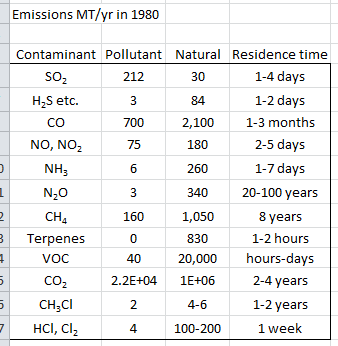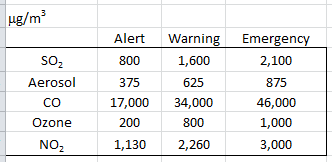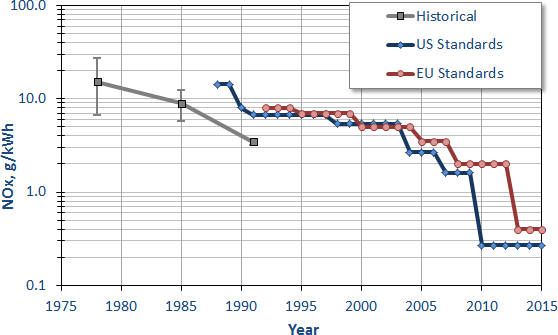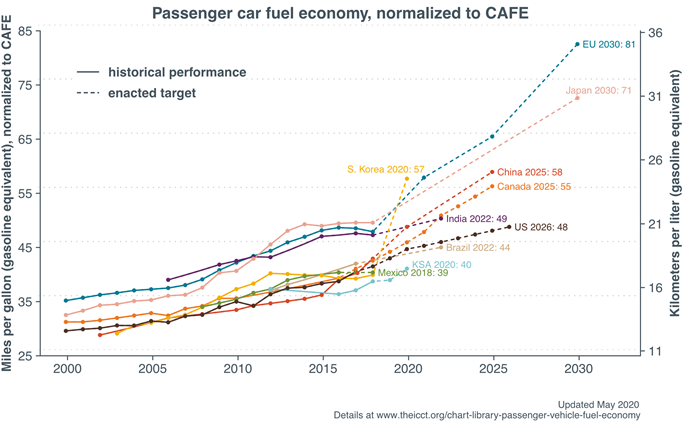On rereading “The limits to growth”, 1972, about the imminent demise of the human race through starvation and pollution, I was struck once again about the modelling assumption that economic growth leads to pollution that kills people and crops. So wanted to read up on the history of how pollution was overcome.
Google turned up nothing of value. Dittto wikipedia. I do have a book on my bookshelf, though, whose first chapter “The history of air pollution” I’ve reproduced in total below.
But first
Pollution can be divided into air pollution, water pollution, soil pollution. I’m not going to divide it further, eg. I’m not going to divide water pollution into water surface, fresh water, oceanic etc.
- Natural pollution
Air pollution gases carbon dioxide, methane, carbon monoxide from bushfires, sulfur dioxide from volcanoes.
Air pollution aerosols dust, salt and bacteria aerosols, carbon nanoparticles.
Water pollution algal blooms, organic poisons, silt, floating vegetation, pumice.
Soil pollution organic poisons, radioactive sand.
- Prehistoric anthropogenic pollution
Soil pollution rotting corpses and food waste, urine and feces.
Water pollution deliberate release of poisons in lakes and atolls for hunting.
Air pollution burning off.
Anthropogenic pollution highlights, sorted by date:
- Gold rush USA & Aus, Silt 1849-1868
result – no anti-pollution measures - London, The great stink 1858
result – the sewerage system, completed 1866 - London pea souper 1952, many deaths
result – Clean air act 1956 - Minimata disease 1956
result – Chisso factory wastewater route changed 1959. US$86 million in compensation - Torrey Canyon 1967
result – no anti-pollution measures - Cuyahoga River fire 1969
result – creation of Environmental Protection Agency 1970 - Los Angeles smog 1970
result – Clean air act 1970. - Eutrophication of the Baltic sea 1972-1978
result – Phosphorus intake of Baltic Sea down by a factor of 4 since 1978 - Acid rain 1974
result – Acid deposition act of 1980 - Love canal 1977
result – Environmental activism starting 1978 - Bhopal disaster 1984
result – US$470 million compensation 1989 - Ozone hole 1985
result – Ban on CFCs 1987
And now for the book chapter. “The history of air pollution”
History of air pollution
BEFORE THE INDUSTRIAL REVOLUTION
One of the reasons the tribes of early history were nomadic was to move periodically away from the stench of the animal, vegetable, and human wastes they generated. When the tribesmen learned to use fire, they used it for millennia in a way that filled the air inside their living quarters with the products of incomplete combustion. Examples of this can still be seen today in some of the more primitive parts of the world. After its invention, the chimney removed the combustion products and cooking smells from the living quarters, but for centuries the open fire in the fireplace caused its emission to be smoky. In A.D. 61 the Roman philosopher Seneca reported thus on conditions in Rome: “As soon as I had gotten out of the heavy air of Rome and from the stink of the smoky chimneys thereof, which, being stirred, poured forth whatever pestilential vapors and soot they had enclosed in them, I felt an alteratoun of my disposition.”
Air pollution, associated with burning wood in Tutbury Castle in Nottingham, was considered “unendurable” by Eleanor of Aquitaine, the wife of King Henry II of England and caused her to move in the year 1157. One hundred-sixteen years later, coal burning was prohibited in London, and in 1306, Edward I issued a royal proclamation enjoining the use of “sea-coal” in furnaces. Elizabeth I barred the burning of coal In London when Parliament was in session. The repeated necessity for such royal action would seem to indicate that coal continued to be burned despite these edicts. By 1661 the pollution of London had become bad enough to prompt John Evelyn to submit a brochure “Fumifugium, or the Inconvenience of the Aer, and Smoake of London Dissipated (together with some remedies humbly proposed)” to King Charles II and Parliament. This brochure has been reprinted and is recommended to students of air pollution. It proposes means of air pollution control that are still viable in the twentieth century.
The principal industries associated with the production of air pollution in the centuries preceding the Industrial Revolution were metallurgy, ceramics, and preservation of animal products. In the bronze and iron ages, villages were exposed to dust and fumes from many sources. Native copper and gold were forged, and clay was baked and glazed to form pottery and bricks before 4000 BC. Iron was in common use and leather was tanned before 1000 BC. Most of the methods of modern metallurgy were known before A.D. 1. They relied on charcoal rather than coal or coke. However, coal was mined and used for fuel before A.D. 1000, although it was not made into coke until about 1600; and coke did not enter metallurgical practice significantly until about 1700. These industries and their effluents as they existed before 1556 are best described in the book “De Re Metallica” published in that year by Georg Bauer, known as Georgius Agricola.
THE INDUSTRIAL REVOLUTION
The Industrial Revolution was the consequence of the harnessing of steam to provide power to pump water and move machinery. This began in the early years of the eighteenth century, when Savery, Pepin, and Newcomen designed their pumping engines, and culminated in 1784 in Watts reciprocating engine. The reciprocating steam engine reigned supreme until it was displaced by the steam turbine in the twentieth century.
Steam engines and steam turbines require steam bolters, which, until the advent of the nuclear reactor, were fired by vegetable or fossil fuels. During most of the nineteenth century, coal was the principal fuel, although oil was used for steam generation late in the century.
The predominant air pollution problem of the nineteenth century was smoke and ash from the burning of coal or oil in the boiler furnaces of stationary power plants, locomotives, and marine vessels, and in home heating fireplaces and furnaces. Great Britain took the lead in addressing this problem, and, in the words of Sir Hugh Beaver:
“By 1819, there was sufficient pressure for Parliament to appoint the first of a whole dynasty of committees “to consider how far persons using steam engines and furnaces could work them in a manner less prejudicial to public health and comfort.” This committee confirmed the practicability of smoke prevention, as so many succeeding committees were to do, but as was often again to be experienced, nothing was done.
“In 1843, there was another Parliamentary Select Committee, and in 1845, a third. In that same year, during the height of the great railway boom, an act of Parliament disposed of trouble from locomotives once and for all (!) by laying down the dictum that they must consume their own smoke. The Town Improvement Clauses Act two years later applied the same panacea to factory furnaces. Then 1853 and t856 witnessed two acts of Parliament dealing specifically with London and cmpowering the police to enforce provisions against smoke from furnaces, public baths, and washhouses, and furnaces used in the working of steam vessels on the Thames.
Smoke and ash abatement in Great Britain was considered to be a health agency responsibility and was so confirmed by the first Public Health Act of 1818 and the later ones of 1866 and 1875. Air pollution from the emerging chemical industry was considered a separate matter and was made the responsibility of the Alkali Inspectorate created by the Alkali Act of 1863.
In the United States, smoke abatement (as air pollution control was then known) was considered a municipal responsibility. There were no federal or state smoke abatement laws or regulations. The first municipal ordinances and regulations limiting the emission of black smoke and ash appeared in the 1880s and were directed toward industrial, locomotive, and marine rather than domestic sources. As the nineteenth century drew to a close, the pollution of the air of mill towns the world over had risen to a peak; damage to vegetation from the smelting of sulfide ores was recognized as a problem everywhere it was practiced.
The principal technological developments in the control of air pollution by engineering during the teenth century were the stoker for mechanical firing of coal, the scrubber for removing acid gases from effluent gas streams, cyclone and bag house dust collectors, and the introduction of physical and chemical principles into process design.
THE TWENTIETH CENTURY
1900-1925
During the period 1900-1923 there were great changes in the technology of both the production of air pollution and its engineering control, but no significant changes in legislation, regulations, understanding of the problem, or public attitudes toward the problem. As cities and factories grew in size, the severity of the pollution problem increased.
One of the principal technological changes in the production of pollution was the replacement of the steam engine by the electric motor as the means of operating machinery and pumping water. This change transferred the smoke and ash emission from the boiler house of the factory to the boiler house of the electric generating station. At the start of this period, coal was hand-fired in the boiler house; by the middle of the period, it was mechanically fired by stokers; by the end of the period, pulverized coal, oil, and gas firing had begun to take over. Each form of firing produced its own characteristic emissions to the atmosphere.
At the start of this period, steam locomotives came into the heart of the larger cities. By the end of the period, the urban terminals of many railroads had been electrified, thereby transferring much air pollution from the railroad right-of-way to the electric generating station. The replacement of coal by oil in many applications decreased ash emissions from those sources. There was rapid technological change in industry. However, the most significant change was the rapid increase in the number of automobiles from almost none at the turn of the century to millions by 1925.
The principal technological changes in the engineering control of air pollution were the perfection of the motor-driven fan, which allowed large-scale gas-treating systems to be built; the invention of the electrical precipitator, which made particulate control in many processes feasible; and the development of a chemical engineering capability for the design of process equipment, which made the control of gas and vapor effluents feasible.
1925-1950
In this period, present-day air pollution problems and solutions emerged. The Meuse Valley (Belgium) deaths occurred in 1930; the Donora, Pennsylvania, deaths occurred in 1948; and the Poza Rica, Mexico, deaths in 1950. Smog first appeared in Los Angeles in the 1940s. The Trail, British Columbia. smelter arbitration was completed in 1941. The first National Air Pollution Symposium in the United States was held in Pasadena. California, in 1949, and the first United States Technical Conference on Air Pollution was held in Washington, D.C. in 1950. The first large-scale surveys of air pollution were undertaken – Salt Lake City, Utah in 1926; New York in 1937 and Leicester, England in 1939. Air pollution research got a start in California. The technical foundation for air pollution meteorology was established in the search for means of disseminating and protecting against chemical, biological, and nuclear warfare agents. Toxicology came of age. The stage was set for the air pollution scientific and technological explosion of the second half of the twentieth century.
A major technological change was the building of natural gas pipelines, and where this occurred, there was rapid displacement of coal and oil as home heating fuel, with dramatic improvement in air quality; witness the much publicized decrease in black smoke in Pittsburgh and St. Louis. The diesel locomotive began to displace the steam locomotive, thereby slowing the pace of railroad electrification. The internal combustion engine bus started its displacement of the electrified streetcar. The automobile continued to proliferate. During this perkid, no significant national air pollution legislation or regulations were adopted anywhere in the world. The first state air pollution law in the United States was adopted by California in 1947.
1950-1980
In Great Britain, a major air pollution disaster hit London in 1952, resulting in the passage of the Clean Air Act in 1956 and an expansion of the authority of the Alkali Inspectorate. The principal changes that resulted were in the means of heating homes. Previously, most heating was done by burning soft coal on grates in separate fireplaces in each room. A successful effort was made to substitute smokeless fuels for the soft coal used in this manner, and central or electrical heating for fireplace heating. The outcome was a decrease in smoke concentration as measured by the blackness of paper fillers through which British air was passed from 175 g/m3 in 1958 to 75 g/m3 in 1968.
During these two decades, almost every country in Europe, as well as Japan, Australia, and New Zealand, experienced serious air pollution in its larger cities. These countries were the first to enact national air pollution control legislation. By 1980, major national air pollution research centers had been set up in England, France, the Netherlands, Sweden, Germany and Japan.
In the United States, the smog problem continued to worsen in Los Angeles and appeared in large cities throughout the nation. In 1955 the first federal air pollution legislation was enacted, providing federal support for air pollution research, training, and technical as-sistance. Responsibility for the administration of the federal program was given to the Public Health Service and remained there until 1970, when it was transferred to the new United States Environmental Protection Agency (EPA). The initial legislation was amended and extended several times between 1955 and 1980, greatly increasing federal authority.
As in Europe, air pollution research activity expanded tremendously in the United States during these three decades. An International Air Pollution Congress was held in New York City in 1955. Three National Air Pollution Conferences were held in Wash-ington, D.C. In 1959, an International Clean Air Conference was held in London. In 1964, the International Union of Air Pollution Prevention Associations (IUAPPA) was formed. IUAPPA has held International Clean Air Con-gresses in London in 1966; Washington, D.C. in 1970; Dusseldorf in 1973; Tokyo in 1977; Buenos Aires in 1980; Paris in 1983; Sydney in 1986 and The Hague in 1989.
Technological interest during these 30 years has focused upon automo-tive air pollution and its control, upon sulfur oxide pollution and its control by sulfur oxide removal from flue gases and fuel desulfurization, and upon control of nitrogen oxides produced in combustion processes.
Air pollution meteorology came of age and, by 1980, mathematical mathatical models of pollution in the atmosphere were being energetically developed. A start had been made in elucidating the photochemistry of air pollution. Air-quality monitoring systems became operational throughout the world. A wide variety of measuring instruments became available.
THE 1980s
The highlight of the 1970s and 1980s has been the emergence of the ecological, or total environmental, approach. Organizationally, this has taken the form of departments or ministries of the environment in governments at all levels throughout the world. In the United States there is a federal Environmental Protection Agency, and in most states and populous counties and cities, there are counterpart organizations charged with responsibility for air and water quality, solid waste sanitation, noise abatement, and control of the hazards associated with radiation and the use of pesticides. This is paralleled in industry, where formerly diffuse responsibility for those areas is increasingly the responsibility of an environmental protection coordinator. Similar changes are evident in research and education.
Pollution controls are now being built into pollution sources – automobiles, power plants, factories – at the time of original construction rather than later on. Also, for the first time, attention has been directed to the problems caused by the “greenhouse” effect of carbon dioxide build up in the atmosphere, possible depletion of the stratospheric ozone layer by fluorocarbons, long-range transport of pollution, prevention of significant degradation, and acidic precipitation, all of which will be discussed later in this book.
THE FUTURE
The air pollution problems of the future are predicated on the use of more and more fossil and nuclear fuel as the population of the world increases. During the lifetime of the students using this book, some respite will be offered by solar, photovoltaic, geothermal, wind, nonfossil fuel (biomass), and oceanic (thermal gradient, tidal, and wave) sources of energy. Some of the agonizing environmental decisions of the next decades will involve a choice between fossil fuel and nuclear power sources and the depletion of future fuel reserves for present needs. Serious questions will arise regarding whether to conserve or to use these reserves – whether to allow unlimited growth or to curb it.
New York City smog 1966.
—-
Some recent good news.

Annual mean SO2 in China.









